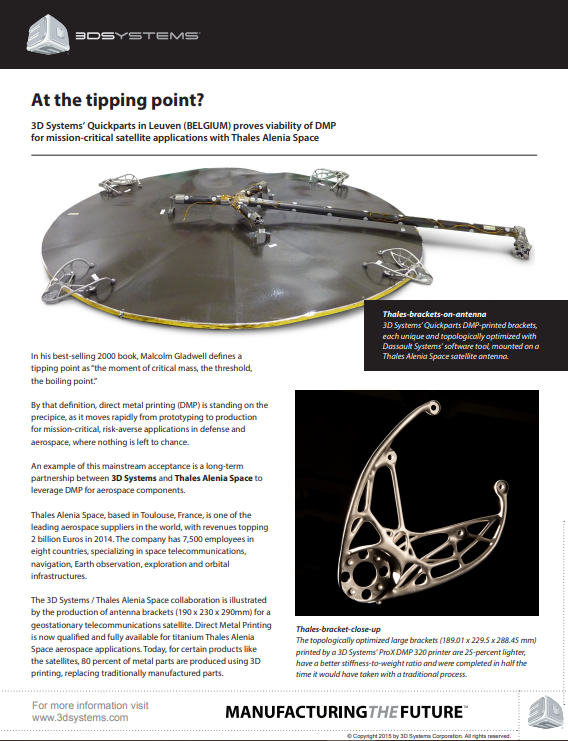CASE STUDY: AT THE TIPPING POINT?
In his best-selling 2000 book, Malcolm Gladwell defines a tipping point as “the moment of critical mass, the threshold, the boiling point.”
By that definition, direct metal printing (DMP) is standing on the precipice, as it moves rapidly from prototyping to production for mission-critical, risk-averse applications in defense and aerospace, where nothing is let to chance.
An example of this mainstream acceptance is a long-term partnership between 3D Systems and Thales Alenia Space to leverage DMP for aerospace components.
Thales Alenia Space, based in Toulouse, France, is one of the leading aerospace suppliers in the world, with revenues topping 2 billion Euros in 2014. The company has 7,500 employees in eight countries, specializing in space telecommunications, navigation, Earth observation, exploration and orbital infrastructures.
The 3D Systems / Thales Alenia Space collaboration is illustrated by the production of antenna brackets (190 x 230 x 290mm) for a geostationary telecommunications satellite. Direct Metal Printing is now qualified and fully available for titanium Thales Alenia Space aerospace applications. Today, for certain products like the satellites, 80 percent of metal parts are produced using 3D printing, replacing traditionally manufactured parts.
Quick and efficient expertise
Thales Alenia Space worked with the 3D Systems’ Quickparts Solutions team in Belgium to design and print the Ti6Al4V brackets and guarantee that all quality aspects and tolerances were met.
Quickparts, a 3D design-to-manufacturing service, is the world’s leading provider of unique, custom-designed parts, offering instant online quoting, expertise in 3D design and printing, and proven post-machining support in order to be able to deliver validated flight parts.
Thales Alenia Space and Quickparts worked together to apply topological optimization to the 3D printing process following a design for manufacturability approach. Topological optimization determines the most-efficient material layout to meet the exact performance specifications of a part. It takes into consideration the given space allowed, loads that need to be handled, boundary conditions and other critical engineering factors.
Each of the four brackets for the satellite required an individualized design, as they are mounted on the antenna’s reflector edges and screwed onto a shaped surface.
Proving its worth
The antenna brackets were produced by Quickparts on a beta version of 3D Systems’ ProX DMP 320 machine. While already in use within 3D Systems manufacturing services operations in Europe and the United States, the printer is scheduled to be announced and available for sale to end users at the International Consumer Electronics Show in January, 2016.
The ProX DMP 320 is designed for heavy-duty metal parts production. It uses a totally new architecture that simplifies set-up and provides the versatility to produce all types of part geometries in titanium (grades 1, 5 and 23), nickel super alloy and Stainless 316L.
Exchangeable manufacturing modules deliver increased applications versatility and less downtime when moving among different part materials. A controlled vacuum build chamber ensures that every part is printed with proven material properties, density and chemical purity.
Extremely low O2 levels in the ProX DMP 320 deliver several key benefits, including better conservation of powder quality, no micro oxidation of parts during printing, fewer oxide interstitials during printing, and improved mechanical properties for O2-sensitive alloys such as titanium.
Better parts in half the time
The combination of 3D Systems’ Quickparts expertise and the advanced capabilities of the ProX DMP 320 delivered exactly what Thales Alenia Space needed in about half the time it would have taken with traditional manufacturing.
The DMP-produced titanium brackets are 25-percent lighter than brackets manufactured by traditional means and feature a better stiffness-to-weight ratio.
Production costs have been reduced considerably and total time from order to shipping—including file preparation, 3D printing, heat treatment, finishing, CNC milling, quality-control analysis, cleaning and data traceability—was four to five weeks, compared to 10 weeks using traditional methods.
Accelerating DMP adoption
Antenna fixation brackets for satellites is just the beginning of the DMP collaboration between 3D Systems’ Quickparts and Thales Alenia Space. In 2015, 3D Systems produced more than 50 different space components for three Thales Alenia Space geostationary satcoms. Thales Alenia expects to double the production in 2016 using DMP from 3D Systems, according to Florent Lebrun, an additive manufacturing specialist for antenna applications.
The collaboration between 3D Systems’ Quickparts and Thales Alenia Space is emblematic of the accelerating adoption of DMP by defense and aerospace organizations worldwide. It appears to be just a matter of time before DMP takes its mainstream place alongside the traditional metal manufacturing processes that it complements.
For further info plese contact 3D-MODEL AG Schweiz: Tel. 043 243 90 36, info@3d-model.ch
